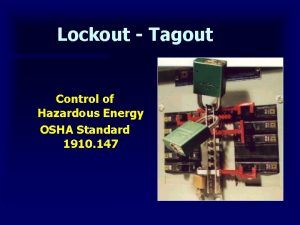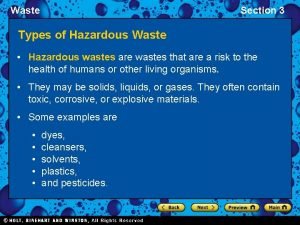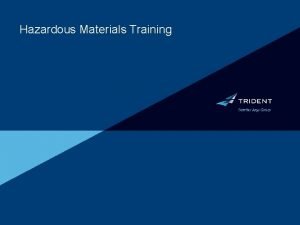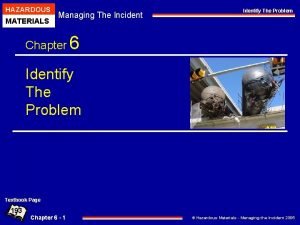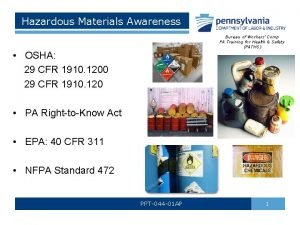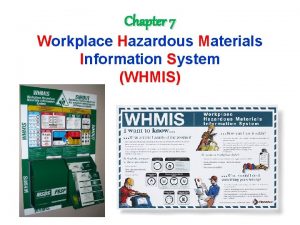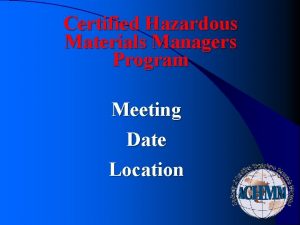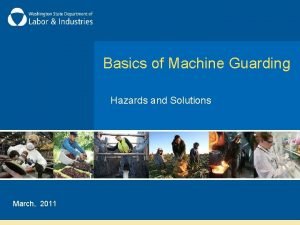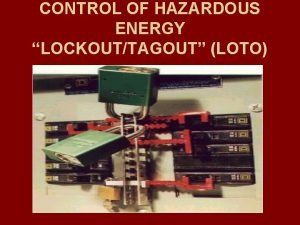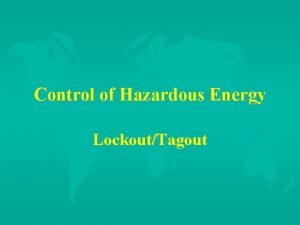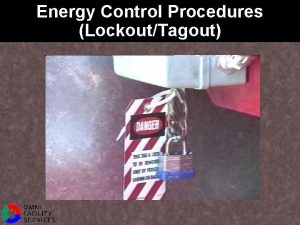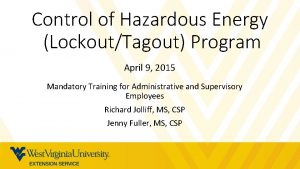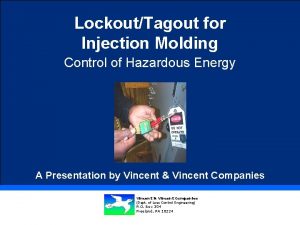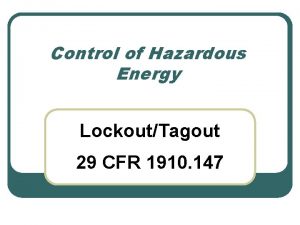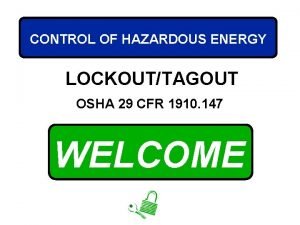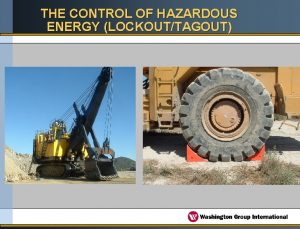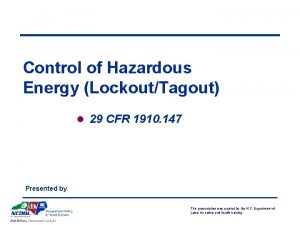LockoutTagout Control of Hazardous Energy This training program
















- Slides: 16

Lockout-Tagout (Control of Hazardous Energy) • This training program is designed to inform management • • • of the requirements of the Lockout-Tagout Program for controlling hazardous energy. This training is not designed to satisfy the Requirements of the Control of Hazardous Energy (lockout-tagout) Standard. An On-Site evaluation and a customized program must be written specific to your work environment in order to satisfy the requirements of the Standard. This program merely informs management of what customization needs to take place. FOR FURTHER INFORMATION CONTACT THE MANAGEMENT HOTLINE.

Lockout-Tagout (Control of Hazardous Energy) • Lockout-Tagout is a term used to identify OSHA regulations designed to protect workers during service and maintenance of machinery and equipment in the work place by ensuring that machinery and equipment cannot be started, operated, or accidentally energized when undergoing service or maintenance. – Employers must develop and implement a Lockout. Tagout Program in writing when employees are exposed to energy sources or moving parts of machinery and equipment during maintenance or service operations. – The written program will identify responsible individuals for each of the following elements along with procedures describing how the elements are accomplished or carried out work place.


Lockout-Tagout (Control of Hazardous Energy) • Application – Lockout-Tagout procedures must be utilized whenever an employee removes or bypasses a safety guard or places their hand or parts of their body into areas of machinery and equipment where moving parts can cause injury. • Assignment of Responsibility – Prior to developing a Lockout-Tagout Program, responsibility for each element for the program must be assigned or designated. Often, a single individual in responsible for the overall program while others are responsible for different elements of the program.

Lockout-Tagout (Control of Hazardous Energy) • Specific Lockout-Tagout Procedures – Specific written procedures must be developed, and utilized for controlling and isolating all energy sources for each type of machinery and equipment in the work place. All energy active and stored sources must be considered including the following: • Electrical • Hydraulic • Pneumatic • Mechanical • Thermal • Fuel • Gravitational

Lockout-Tagout (Control of Hazardous Energy) Note: Specific procedures need not be developed for machinery and equipment that is cord and plug connected when electricity is the only energy source to the machine and is provided to the machine is by the cord and plug and the cord and plug can be controlled by the person performing service or maintenance on the machine or equipment.

Lockout-Tagout (Control of Hazardous Energy) – Specific lockout-tagout procedures will include the following: • Identification of machinery or equipment • Types and magnitudes of energy sources • Location of all energy source lockout(s) • Types of isolating devices (locks, tags, etc. ) required • Sequence of procedures for shutdown of the machine or equipment (including notification of affected employees) • Procedures for testing the effectiveness of the lockout to zero energy state (including stored energy) • Procedures for reenergizing and restarting the machine or equipment

Lockout-Tagout (Control of Hazardous Energy) • A list of authorized and affected employees – Authorized persons are those employees trained and qualified to conduct or utilize a lockouttagout procedure – Affected persons are those employees that operate or work near or around machinery or equipment that will be affected by the shut down and lockout-tagout procedure

Lockout-Tagout (Control of Hazardous Energy) • Isolating Devices (locks, tags, lockouttagout equipment) – Isolating devices must prevent starting, operating, or energizing, cycling, and movement of the machine or equipment – Locks used in lockout-tagout procedures must be specifically designated and identified for that purpose (lockout labeling on the lock, unique color code, etc, ) Note: There may be only one key for each lock in circulation and the key must be in constant control of the authorized person placing the lock

Lockout-Tagout (Control of Hazardous Energy) – Each authorized employee involved in the service or maintenance process must affix their own lock and it must remain in place as long as the employee is involved and provide continuity though shift changes – Each lock affixed in a lockout procedure must identify the authorized person placing the lock Note: Can be identified on the tag if attached to the lock hasp.

Lockout-Tagout (Control of Hazardous Energy) – A durable tag must be affixed at the point of lockout for each procedure as a warning device and must clearly display warnings such as “Do Not Start” “Do Not Open” “Do Not Close” “Do Not Energize” “Do Not Operate”

Lockout-Tagout (Control of Hazardous Energy) • Periodic Inspection – Employers must conduct a periodic inspection of the energy control procedure at least annually to ensure that the procedures and Lockout-Tagout Program requirements are being followed. • The periodic inspection must be performed by an authorized employee other than those utilizing the energy control procedure being inspected • The periodic inspection must include a review between the inspector and each authorized employee of the responsibilities under the energy control procedure being inspected – Records of the periodic inspection must be maintained in writing

Lockout-Tagout (Control of Hazardous Energy) • Employee Training and Information – Employers must develop procedures to ensure and require that employees are trained prior to initial assignment (upon hiring) and adequately and periodically thereafter (at least annually) on the following: • Authorized Employees – All elements of the Lockout-Tagout Program – Recognition of applicable hazardous, type, and magnitude of the energy sources in the workplace, and the procedures for energy isolation and control.

Lockout-Tagout (Control of Hazardous Energy) • Affected Employees – Recognizing lockout-tagout procedures and devices – Purpose of the energy control procedure – Records including names of employees trained, date of training, and contents of the training must be maintained.


Lockout-Tagout (Control of Hazardous Energy) • Contractor Information – Whenever outside contracted servicing personnel are to be service and maintenance of machinery and equipment, the employer and the outside contractor must inform each other of their respective lockouttagout procedures.
 Hazardous area training darwin
Hazardous area training darwin Tagout
Tagout Energy energy transfer and general energy analysis
Energy energy transfer and general energy analysis Energy energy transfer and general energy analysis
Energy energy transfer and general energy analysis Section 3 hazardous waste answers
Section 3 hazardous waste answers Aviation hazardous attitudes
Aviation hazardous attitudes Biomedical waste management definition
Biomedical waste management definition Dot
Dot Hazardous materials table
Hazardous materials table Us military marking system for hazardous materials
Us military marking system for hazardous materials Pa-psfa-hazardous materials awareness
Pa-psfa-hazardous materials awareness Five hazardous attitudes
Five hazardous attitudes 5 hazardous attitudes
5 hazardous attitudes Shape and color of whmis 2015 symbols
Shape and color of whmis 2015 symbols Isachmm
Isachmm Transverse motion machine
Transverse motion machine Hazardous waste apes
Hazardous waste apes

